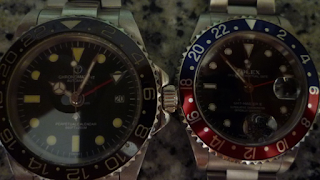(The following blog first appeared on my companion website Wrist Watch Redux in February 2016.)
Two of my favorite things: Deep-dive research and wristwatch vignettes -- those idiosyncratic incidents that put a wristwatch at the center of a memorable tale.
Here my focus is on Bernard Berenson (1865-1959) who is often acknowledged as the 20th Century's greatest art historian of the Italian Renaissance, his wrist and his wristwatch.
 |
| Bernard
Berenson. Photo appearing in Italophile Book Reviews,
http://italophilebookreviews.blogspot.com/2014/07/the-florentinevenetian-painters-of.html. Photographer and date of original unknown. |
In Meryle Secrest's 1979 biography, Being Bernard Berenson, the author spends one page (384) retelling an amusingly controversial incident.
Principally it involves three of Berenson's intimates and an unnamed journalist.
Character No. 1 is Igor Markevitch, a Ukranian-born composer and conductor. He and his wife spent seven years living with Berenson, his wife Mary, and his secretary Nicky Mariano at a villino on the grounds of "i Tatti," Berenson's Tuscan estate outside of Florence, Italy;
Character No. 2 is Bertram M. Goldsmith, a Post-World War II American friend of Berenson who served as Military Governor of Florence after the city's liberation in August 1944. He and his wife frequently visited Berenson.
Character(s) No. 3 is Berenson, or more specifically the man, his wrist and the watch that he wore.
This is how the story goes according to Secrest:
(Quoting Markevitch): "One day after the liberation of Florence a journalist came to interview me about Berenson. He was so persistent that I got bored and to amuse myself, I started inventing stories. I said that Berenson was just like the princess and the pea, who felt the lump through seventeen mattresses, and that he even had to have his watch warmed for him. After the journalist left I told Berenson about it and we had a good laugh."
(Quoting Goldsmith): "It's true! [the watch-warming story]. I saw it with my own eyes!" He goes on to say that on one of his postwar visits at i Tatti, he and his wife were having aperitifs with Berenson and Nicky when "all of a sudden a butler arrived carrying a red velvet cushion. On the cushion was a white towel and on the towel a was a warmed watch. We asked about it and Nicky Mariano explained, 'We never let him put his watch on, because of the shock of the cold against his arm.'"
Prior to Secrest's publishing the story in 1979, the warmed watch tale circulated in the postwar popular media. Life Magazine, April 11, 1949 said in its article, "Life Calls on Bernard Berenson,":
"He leads a highly punctilious and fastidious daily life under the watch of and supervision of his secretary, Nicky Mariano. Promptly at 6 a.m., B.B. awakens, and propped up on his canopied bed, reads, writes or receives visitors until 10, when he gets up. A vase of fresh flowers is placed in his room, and a butler warms up B.B.'s wrist watch, which he finds unpleasant to strap on when it is cold."
Berenson would have been 84 at the time of this Life article.
 |
| Bernard
Berenson at rest. Photo appearing in the archives of Writers at Work
http://writersatwork.pfauth.com/post/21971201256/bernard-berenson Photographer and date of original unknown. |
For me, the intriguing aspect of this vignette is its ultimate inconclusiveness.
Who is to say that the joke was really on Markevitch and Berenson was the jokester letting his friend think that he had fabricated what was really the truth?
Or was what started out as Markevitch's fabricated detail of toilette to become for Berenson a part of his morning and afternoon daily routines?
Both would be in keeping with one of Berenson's famous quotes:
"Give us today our daily idea and forgive us all those we thought yesterday."
(Note: Meryle Secrest is a noted American biographer who has written books on Romaine Brooks, Kenneth Clark, Salvador Dalí, Frank Lloyd Wright, Leonard Bernstein, Stephen Sondheim, Richard Rodgers, Joseph Lord Duveen, Amedeo Modigliani, and Elsa Schiaperelli.)


















